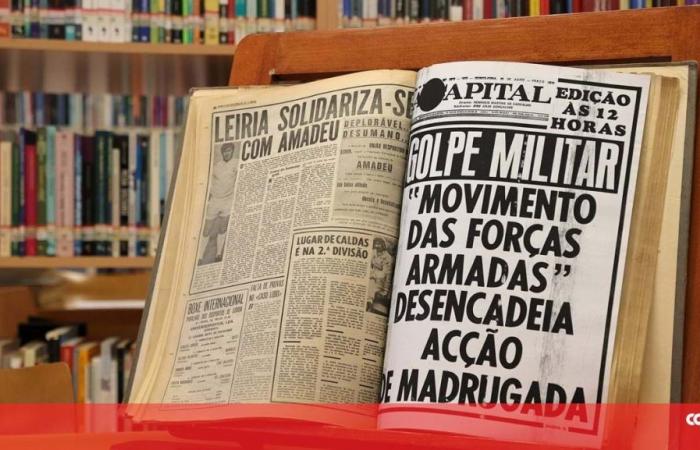Books, newspapers, posters, stickers and sound and audiovisual recordings are among the collection of the revolution that is distributed across various locations.
In the early hours of April 25, 1974, “Operação Fim de Regime”, led by young captains, put an end to 48 years of dictatorship in Portugal. Half a century later, the country still lacks a national space that allows one to visit and learn about part of the thousands of documents inherited from the Carnation Revolution.
At the suggestion of the 25 de Abril Association, created by the military who sparked the revolution, an Interpretive Center for the Revolution will finally be created, in Terreiro do Paço, in Lisbon. But its opening will only take place in two years, in 2026, in the final period of the celebrations of the half century of the revolution.
For its implementation, the State will provide the facilities of the Ministry of Internal Affairs and finance the project. In turn, the Lisbon City Council will ensure the works on the square and the management of the cultural equipment, through the Lisbon Tourism Association.
In the fifty years of celebrating democracy, the Morning mail sought to find out where most of Abril’s heritage is at the moment.
Safe of the revolution at the University of Coimbra
The University of Coimbra is the authentic vault of the heritage of the freedom revolution. The 25 de Abril Documentation Center (CD25A) brings together more than five thousand cataloged documents, including books, leaflets, articles and periodicals; around 300 archive funds treated; more than 7500 photographs; approximately 5 thousand posters and 900 folders, containing press clippings; in addition to a number very close to 45 thousand pamphlets, around 6 thousand stickers and at least 2,600 sound and audiovisual recordings.
“We are one of the largest national archives on Portugal’s recent political history. It is the private papers of activists, politicians and military personnel that set us apart”, says Natércia Coimbra, deputy director of CD25A.
CD25A, created in December 1984, aims to organize and make available to scientific research the valuable documentary material dispersed throughout the country and abroad, on the Portuguese democratic transition.
Military guards archive in Lisbon
On Rua da Misericórdia, in Lisbon, the soldiers who carried out the Carnation Revolution preserve an important part of the April documents, in a collection of films, posters, documents or letters relating to the fight for freedom.
On the 50th anniversary of the revolution, the association has an exhibition of posters that were pasted and spread across all cities, towns and villages.
“The posters were the image of the feeling that prevailed among people after the 25th of April”, explains the vice-president of the 25th of April Association, Colonel Aprígio Ramalho.
Created by the military involved in the 25th of April, the association has a cultural and civic profile, and is not a military organization.
Newspapers from the revolution preserved in Lisbon
With the revolution underway, the press immediately released several editions about the first day of freedom. The entire country wants to read in the newspapers, listen to the radio or watch the revolution unfold on TV. Part of this heritage is in the Lisbon Municipal Hemeroteca.
“The newspapers of the time are primary sources of the greatest importance for creating the history of events”, explains Álvaro Costa de Matos, director of the Hemeroteca Municipal de Lisboa.
The newspaper library has a digital folder where it is possible to access these contents. Also in Lisbon, at the National Library of Portugal and Torre do Tombo it is possible to consult newspapers from the time.
Art in April
In one of the examples of the artistic expression of the 25th of April, the Arpad Szenes-Vieira da Silva Foundation preserves the original of one of the two posters by Maria Helena Vieira da Silva. Casa-Atelier Coordinator, Inês Eva, tells how the posters came about.
The suggestion for creating the posters came from writer Sophia de Mello Breyner Andresen. The painter accepted the suggestion and the result is on display at the foundation.
Other places to see the Art of April are the Casa das Histórias Paula Rego, in Cascais, or the Gulbenkian Modern Art Center, in Lisbon, scheduled to reopen on September 20th.
Mário Soares Foundation
The Mário Soares and Maria Barroso Foundation houses one of the most extensive and relevant Portuguese political archives of the 20th century, comprising personal and political documentation of Mário Soares and Maria Barroso and various collections essential for understanding the History of Portugal, Europe and the World . Themes such as republicanism, colonialism, anti-colonialism, opposition to dictatorship, democratic transition and European construction are present in the foundation’s archive.






